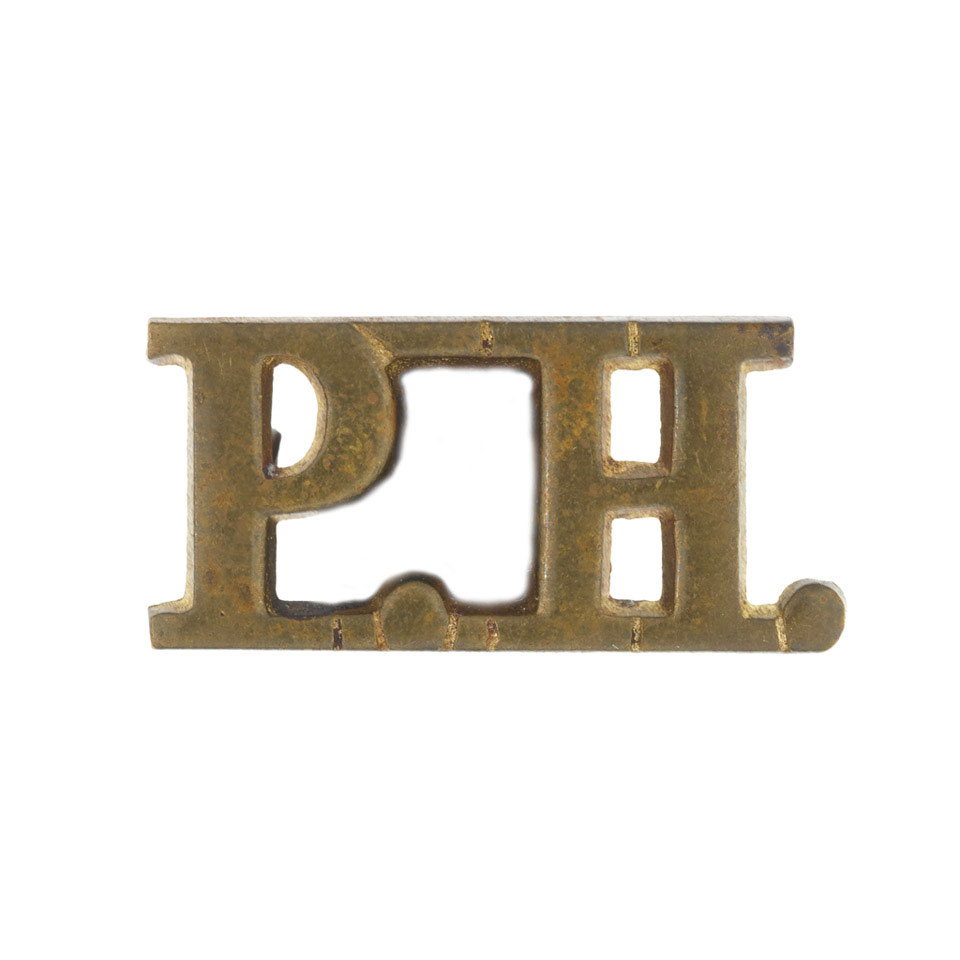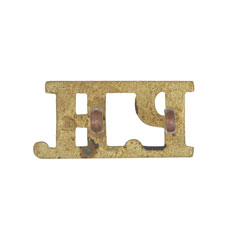
Online Collection
Shoulder title, 17th Queen Victoria's Own Poona Horse, 1937-1947
Brass title in the form of the regiment's initials, 'PH'.
Following World War One (1914-1918), the number of Indian Cavalry Regiments was reduced from 39 to 21. Rather than further disbandments, the regiments were amalgamated in pairs. The 17th Queen Victoria's Own Poona Horse was formed by an amalgamation of the 33rd Queen Victoria's Own Light Cavalry and the 34th Prince Albert Victor's Own Poona Horse. It was initially titled 33rd/34th Cavalry but was renamed as the 17th Queen Victoria's Own Poona Horse in 1922.
The new regiment inherited the combined battle honours of: 'Corygaum', 'Ghuznee 1839', 'Affghanistan 1839', 'Cabool 1842', 'Candahar 1842', 'Meeanee', 'Hyderabad', 'Persia', 'Reshire', 'Khoosh-ab', 'Bushire', 'Central India', 'Abyssinia', 'Kandahar 1880', 'Afghanistan 1878-80', 'China 1900'. For the First World War: 'La Bassée 1914', 'Armentières 1914', 'Somme 1916', 'Bazentin', 'Flers-Courcelette', 'Cambrai 1917', 'France and Flanders 1914-17', 'Megiddo', 'Sharon', 'Damascus', 'Palestine 1918', 'Shaiba', 'Ctesiphon', 'Tigris 1916', 'Mesopotamia 1914-16'; and 'Afghanistan 1919'.
In 1927 the regiment's title was changed to The Poona Horse (17th Queen Victoria's Own Cavalry) and, just prior to the outbreak of World War Two (1939-1945), it was selected as one of two regiments to remain horse-based whilst the rest of the cavalry mechanised. As other regiments mechanised, the unit had the pick of horses from remounts and other regiments and briefly became the best turned out cavalry regiment to be seen. However the decision was overturned on the outbreak of war and the regiment was mechanised as reconnaissance light cavalry, equipped with Bren carriers and Chevrolet support trucks.
The end of 123 years of mounted service was marked at the 'Last Mounted Parade', carried out in full dress on 18 January 1941 in front of a large crowd including members of the public and British and Australian soldiers.
The regiment was attached to the 6th Indian Division and deployed to Iraq, just as their forebears had done in 1914. It was encamped close to the spot where the regiment had fought at Shaiba. The unit then undertook an arduous overland transfer from Northern Iraq via Palestine to Egypt, where it took part in the North Africa Campaign, earning the battle honour 'North Africa 1940-43'. The regiment later garrisoned in the Middle East and Cyprus. By 1946 the regiment had returned to India and, upon Partition in 1947, it was allocated to the Indian Army.
From the Field Marshal Sir John Chapple Indian Army Collection.
NAM Accession Number
NAM. 2013-10-20-18-41
Copyright/Ownership
National Army Museum Copyright
Location
National Army Museum, Study collection
Object URL
https://collection.nam.ac.uk/detail.php?acc=2013-10-20-18-41


